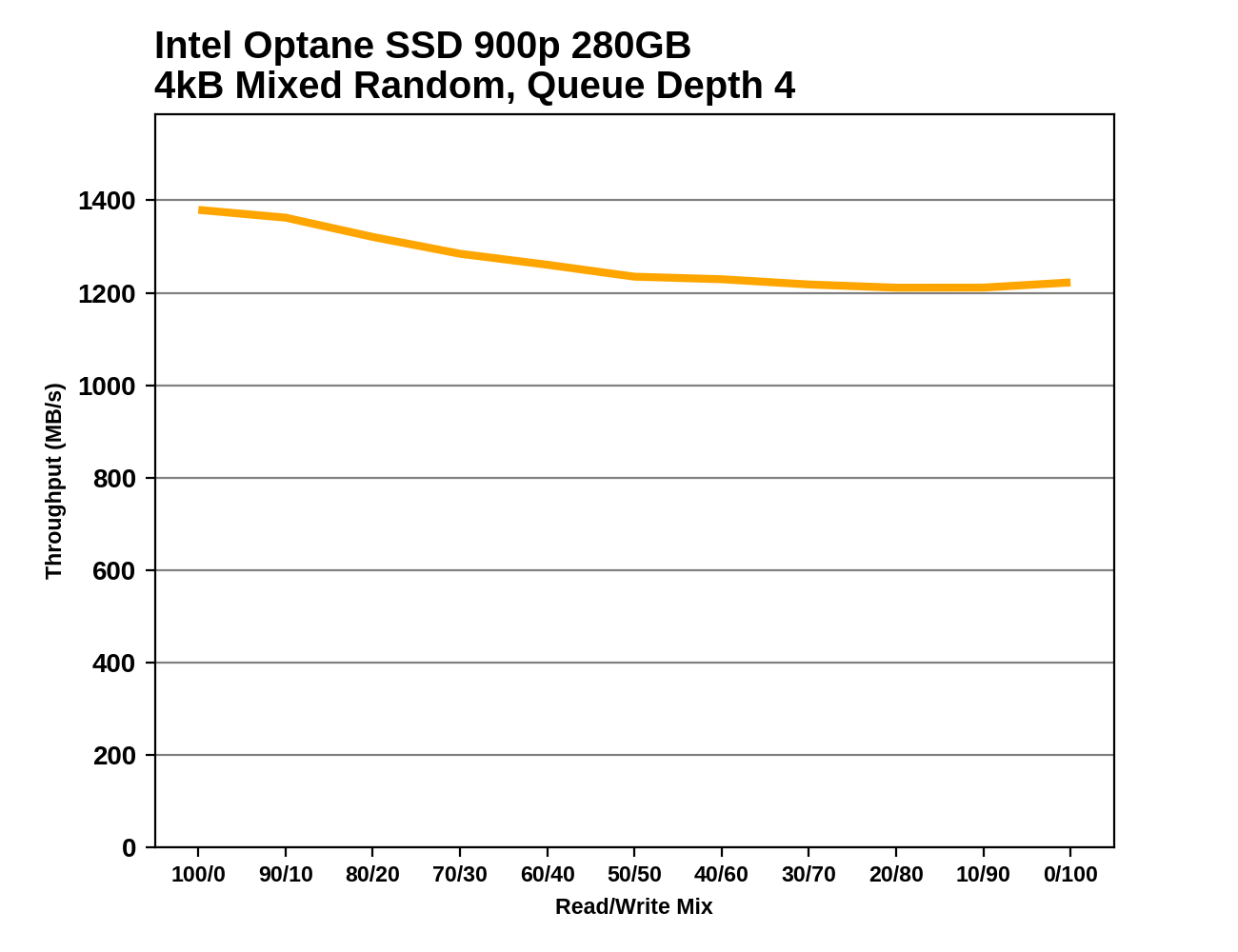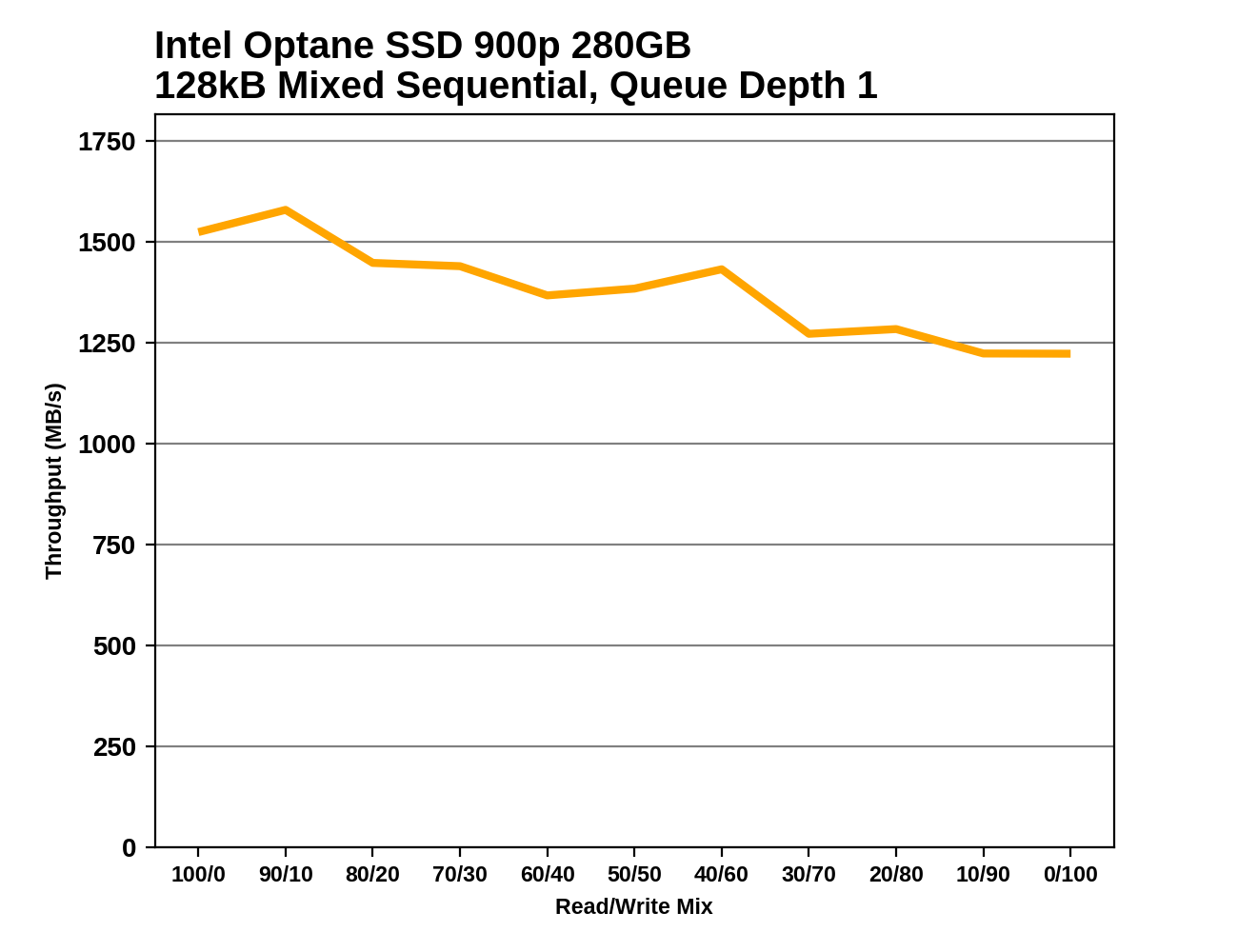The Intel Optane SSD 900P 280GB Review
by Billy Tallis on October 27, 2017 9:30 AM ESTMixed Random Performance
Our test of mixed random reads and writes covers mixes varying from pure reads to pure writes at 10% increments. Each mix is tested for up to 1 minute or 32GB of data transferred. The test is conducted with a queue depth of 4, and is limited to a 64GB span of the drive. In between each mix, the drive is given idle time of up to one minute so that the overall duty cycle is 50%.

The mixed random I/O performance of the Intel Optane SSD 900P is completely unmatched. The small Optane Memory M.2 is the second fastest drive we've tested, and the fastest flash-based SSD is only a third as fast as the Optane SSD overall.
 |
|||||||||
At the very end of the test, when the workload shifts to pure random writes, Samsung's fastest SSDs are able to batch the writes and dramatically improve throughput, almost enough to catch up to the slowest speed the Optane SSD hits during this test.
Mixed Sequential Performance
Our test of mixed sequential reads and writes differs from the mixed random I/O test by performing 128kB sequential accesses rather than 4kB accesses at random locations, and the sequential test is conducted at queue depth 1. The range of mixes tested is the same, and the timing and limits on data transfers are also the same as above.

The Intel Optane SSD 900P doesn't quite dominate the mixed sequential I/O test to the extent that it trounced the competition in the mixed random I/O test, but it still breaks the record with a 40% higher average throughput than the fastest flash-based SSD.
 |
|||||||||
The Optane SSD 900P's performance wavers a bit as the workload changes, but the general trend is a gradual reduction in performance as the proportion of writes increases. The flash-based SSDs tend to show an sharper decline in performance during the first half of the test, and the good ones recover most of that performance over the course of the second half. But the low performance in the middle of the test brings the averages way down and leaves the Optane SSD alone at the top.










205 Comments
View All Comments
Lolimaster - Saturday, October 28, 2017 - link
The past is the past, few years ago, a 20GB HDD cost $200 so?btb - Saturday, October 28, 2017 - link
Does the Optane 900P have support for hardware based Bitlocker encryption?Currently I have a motherboard with a TPM, and an SSD with Microsoft eDrive/TCG Opal/IEEE 1667 support, and thus support for hardware based(not software) Bitlocker.
Would the Optane work in a similar manner, if I use it as a boot drive?
voicequal - Saturday, October 28, 2017 - link
Mixed reads & writes are a significant weak spot for SSD performance, where a sequential write workload can degrade a sequential read workload and vice versa. It looks like Optane has completely resolved this (no more bathtub curve). It would be interesting to see a mixed sequential test with QD > 1, so that both read & write requests are in the queue. In theory, throughput could be 2x under 50/50 mixed workloads if Optane is fast enough to saturate the full duplex paths, like the PCIe bus, in both directions.evilpaul666 - Saturday, October 28, 2017 - link
I ordered a 480GB AIC version from the popular online vendor. I was surprised it was actually available. Seems to be bucking a trend this year.Hopefully, Intel ironed out the bugs and there won't be crashes until multiple firmware updates over the next year.
Anecdotally, I've heard good things about improved UX. I'll find out in a few days. It's replacing an Intel 750 400GB from about two years ago.
Mikewind Dale - Saturday, October 28, 2017 - link
This is awesome. But what excites me most is using XPoint to replace RAM.I wonder, can we get an approximate simulation of what that world could be like, by making a system with a deliberately minuscule amount of RAM, installing a 32 GB Optane module, and setting the Windows page file to be on that Optane module? I'd be interested to see some benchmarks.
evilpaul666 - Saturday, October 28, 2017 - link
There was a demo of a system with only 4GB RAM that was supposed to have had good results."Bullwinkle J Moose" - Saturday, October 28, 2017 - link
Would System Start-up be any faster?---------------------------------------------------
Faster that what? Apples to Bannana's?
A 35 Watt Dualcore Sandy bridge will boot a fresh install of Windows 10 Fall Crapper Edition (Sept 2017) in 5.35 seconds to a Samsung 850 Pro
or, the same computer will boot a fresh install of Windows XP-SP2 in 3 - 4 seconds (it varies every boot)
Then, I've seen people bragging on youtube for booting new 90+ Watt Quadcore machines to Windows 10 on an M.2 drive in 17 seconds
So, wutz your opinion?
How fast is fast ?
cheshirster - Sunday, October 29, 2017 - link
Those prices are FAKE.CaedenV - Sunday, October 29, 2017 - link
Come on Intel! Storage isn't what this tech is made for! This was supposed to have faster throughput and act as a RAM replacement, not SSD replacement! Being able to replace RAM and storage with something that is slightly slower than RAM, but the capacity of a large SSD would have huge benefits. Imagine 'launching' a program and all that needs to be done is to flip a flag from inactive to active and your whole program is up and running. No loading from the HDD/SSD into RAM, just activate a section of memory and update the windows registry keys if needed. Having direct HDD/SSD access to the CPU without needing to load into RAM first. These would be huge advantages. But instead Intel saw that it wasnt going to be good enough for that so they released what they had as a way to cash in and make up for all of the wasted R&D on this tech over the years.Granted; it is not ALL bad. For consumers this would be like burning money. But for business use this is amazing tech. At my work we have a huge document management system with some ~6 million documents in it, and 200+ users running searches on them all the time. On HDD these searches would take just over a minute. We recently moved the search cache to SSDs which dropped the search time down to ~10-20 sec. With Optane we could lower it to near instant search times. Not going to do it any time soon, but there is absolutely a market for this kind of tech in the business IT world. I just don't understand why Intel is marketing it to gamers.
Reflex - Sunday, October 29, 2017 - link
To be fair, the software ecosystem is a decade or more behind the concept of unified memory. Even if this was a capable RAM replacement today, nothing could take advantage of it, and wouldn't be able to for a very long time.